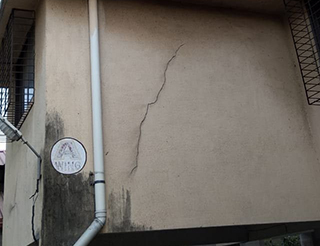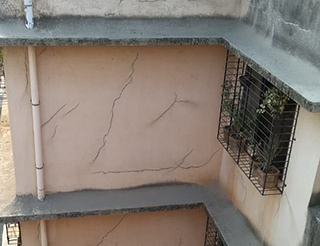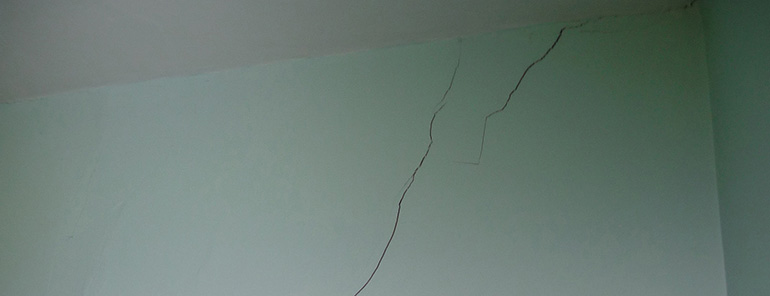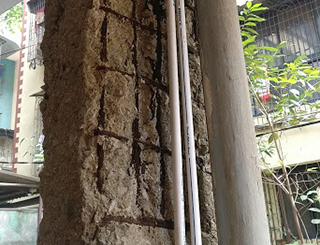External Waterproofing
Cracks repairs
Cracks appear in a wall for a number of reasons. They can occur as a new house ‘settles’ or when the construction materials expand and contract overtime with environmental changes as well as when the foundations of the house move. It is important to establish the root cause and then to take professional advice and make a judgement as to what action to take. Some minor cracking occurs naturally and there is no need for concern or action although it is always worth monitoring them closely for any change. There are other cracks that will need some form of repair work and others that will need more immediate and drastic attention.
Ease of repair.
1. Hairline cracks of less than about 0.1 mm which are classed as negligible. No action required.
2 - Fine cracks that can be treated easily using normal decoration. Damage generally restricted to internal wall finishes; cracks rarely visible in external brickwork. Typical crack widths up to 1 mm.
3 - Cracks easily filled. Recurrent cracks can be masked by suitable linings. Cracks not necessarily visible externally, some external repointing may be required to ensure weather-tightness.

Doors and windows may stick slightly and require easing and adjusting. Typical crack widths up to 5 mm. 3 - Cracks that require some opening up and can be patched by a mason. Repointing of external brickwork and possibly a small amount of brickwork to be replaced. Doors and windows sticking. Service pipes may fracture. Weather-tightness often impaired. Typical crack widths are 5 to 15 mm, or several of, say, 3 mm.
4 - Extensive damage which requires breaking-out and replacing sections of walls, especially over doors and windows. Windows and door frames distorted, floor sloping noticeably. Walls leaning or bulging noticeably, some loss of bearing in beams. Service pipes disrupted. Typical crack widths are 15 to 25 mm, but also depends on number of cracks.
5 - Structural damage that requires a major repair job, involving partial or complete rebuilding. Beams lose bearing, walls lean badly and require shoring. Windows broken with distortion. Danger of instability. Typical crack widths are greater than 25 mm, but depends on number of cracks.
Usefully, the BRE link the width and number of cracks to the appropriate type of repair. The first three types of crack - 0, 1, 2 – only require redecoration and no major work. Those cracks described in 3 and 4 require more major work but it is only the fifth type of crack that indicates severe structural damage and needs urgent attention from a professional surveyor.
It is important to point out that even with smaller cracks, you should monitor them over time in case they increase in width, which could be indicative of a more serious underlying issue. Those cracks that emerge over a short space of time, even small ones, are also potential causes of concern when compared to those that have been there for years.
A professional structural engineer should be consulted to confirm any diagnosis as well as appropriate course of action.
Identifying Cracks in External Walls
There are two main types of crack that can appear in your masonry walls – vertical and stepped.
Vertical Cracks

Vertical cracks usually occur in foundation walls when there is insufficient support below. The mean reason for this lack of support is when the soil beneath the foundation has not been properly compacted and compresses or even washes away.
The following is an example of a vertical crack:
Stepped Cracks

Stepped cracks usually follow mortar joints and are most common near the corners of buildings. They usually occur through wall movement related to foundation movement including subsidence.
The following is an example of a stepped crack:
Internal Cracks
You may also experience the following types of internal crack in your home:
Internal Cracks in Plaster Walls

Cracks around Windows and Doors

Structural repairs

These type of repairs includes removal of old loose plaster till the brick level, and replaster the same with specific cement sand ratio. Certain factors regarding the sand to be used should also be taken into consideration. Sand with mud content, silt content should be avoided and use of pure river sand is advisable during the repair process. It’s advisable to use waterproofing additives to alter the cement mortar to ensure good quality plaster which can last for longer period of time.
Repairing of loose plaster is very necessary. Because of carbonation effect over a period of time the bond between cement and sand tends to become weak because of this, the portion of that plaster becomes porous and from that porous surface water seepage is inevitable. As soon as we see some dark patches, white patches inside the respective flats immediate action should be taken regarding the loose plaster treatment.
Structural repair precisely points towards column and beams of the structure. As the building ages it is certain that the column and beam which are under constant tension and pressure tend to develop cracks. These crash has to be treated with utmost care. Structural auditor or consultant can guide the exact method and procedure for the respective damage.